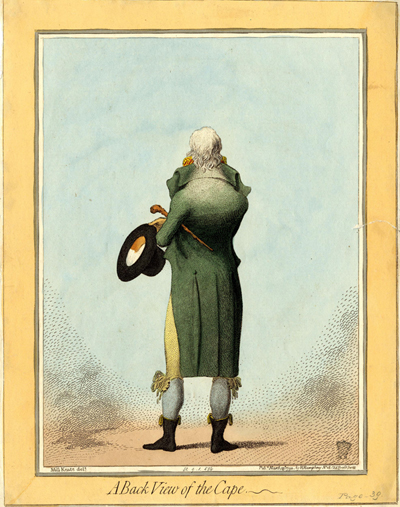A Back View of the Cape
This is one of a pair of prints satirizing (for once) the male fashions of the day. The other was Neck or Nothing. Not perhaps surprisingly the two prints, though etched by Gillray, were both drawn by a young woman, Georgiana Keate, the daughter of writer, poet, playwright, and artist, George Keate.

© Trustees of the British Museum
The prints were published on the same day, March 23, 1792 and were clearly intended as a pair, showing a front and back view of many of the same styles. Both present single figures against a virtually blank background. Both figures wear their natural hair frosted with white powder. Both hold the same round black hat with a hat tax license inside. Both carry a fashionable bludgeon a la George Hanger, the companion of the Prince of Wales. Both wear jackets with high collars and full cravats. The differences are primarily in their breeches and footwear.
Geogiana Keate came from a privileged background. Her father corresponded with Voltaire, was friends with David Garrick and Angelica Kauffman, and was said to have had one of the finest shell collections in England. It may have been through her father's interest in shells that the connection with Gillray was made. George Humphrey, whose daughter was Gillray's principal publisher, was a prominent dealer in shells.
Georgiana had tutors in art, dance, and music, and was already doing portraits and landscapes in her teens. In 1791 (age ~20 or 21) she was an "Honorary Exhibitor" at the annual exhibition of the Society of Artists. She submitted four paintings: May Day, Election Squabble, Scene in Shakespeare's play of King John,, and Mrs. Jordan in the character of Hippolita; drawn from recollection.
The title of A Back View of the Cape sounds like the kind of clue one finds in portrait caricatures, since the image itself does not present a cape. However, I have not identified a likely subject. But Georgiana would have heard stories of Cape Horn from family friends like Captain Henry Wilson whose craft was shipwrecked on one of the Pellew Islands off the coast of Australia, and Captain William Bligh, whose mutinous crew members abandoned him and his loyal sailors in an open boat near Tahiti.
Sources and Reading
- Commentary from the British Museum on A Back View of the Cape
- "Georgiana Keate," Wikipedia
- "George Keate," Wikipedia
- The Society of Artists of Great Britain. . .
- Susan Bennett, A Thankless Child: The Life and Times of Georgiana Jane Henderson (1771-1850), 2020.
Comments & Corrections
NOTE: Comments and/or corrections are always appreciated. To make that easier, I have included a form below that you can use. I promise never to share any of the info provided without your express permission.